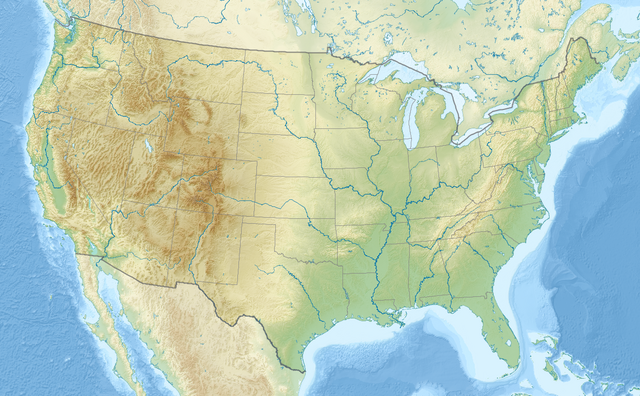Rosman_Satellite_Tracking_Station
Pisgah Astronomical Research Institute
Observatory
Pisgah Astronomical Research Institute (PARI) (pronounced perry) is a non-profit astronomical observatory located in the Pisgah National Forest near Balsam Grove, North Carolina. PARI operates multiple radio telescopes and optical telescopes for research and teaching purposes. The observatory is affiliated with the University of North Carolina system through the Pisgah Astronomical Research and Science Educational Center (PARSEC).
This article includes a list of general references, but it lacks sufficient corresponding inline citations. (April 2014) |
 Smiley with 26 West in the background | |||||||||||||||||||||||
| Observatory code | H70 | ||||||||||||||||||||||
|---|---|---|---|---|---|---|---|---|---|---|---|---|---|---|---|---|---|---|---|---|---|---|---|
| Location | Balsam Grove, North Carolina | ||||||||||||||||||||||
| Coordinates | 35.1996°N 82.8724°W / 35.1996; -82.8724 | ||||||||||||||||||||||
| Altitude | 2,999 feet (914 m) | ||||||||||||||||||||||
| Established | January 1999 (1999-01) | ||||||||||||||||||||||
| Website | pari | ||||||||||||||||||||||
| Telescopes | |||||||||||||||||||||||
| |||||||||||||||||||||||
| | |||||||||||||||||||||||
PARI is located at the site of the former Rosman Satellite Tracking Station, which was established by the National Aeronautics and Space Administration (NASA) in 1962. The site was part of the worldwide Spacecraft Tracking and Data Acquisition Network and an integral communications link for the crewed space programs Project Gemini and Project Apollo.
The facility was transferred to the National Security Agency (NSA) in 1981. Known as the Rosman Research Station, it was used as a signals intelligence gathering facility. The site was closed by the NSA in 1995 and transferred to the United States Forest Service.[1]
After several years of inactivity, the federal government proposed to dismantle the facility. Recognizing the utility of the site, a small group of interested scientists and businessmen formed a not-for-profit foundation, which acquired the site in January 1999. It has continued capital investment at the facility, enabling updates of the equipment for astronomical observation purposes. A staff of professional astronomers, engineers, and other scientists work at the observatory.
In the early morning hours of Dec 24th, 2012, the institute was burglarized. Its collection of about 100 meteorites, valued at at least $80,000 and with specimens weighing up to 80 pounds, was stolen, along with about $100,000 worth of TVs, monitors, projectors, microscopes, and other scientific equipment. [2]Much of the stolen property, including the meteorite collection, was recovered within a week. [3]
PARI hosts research and study programs with Furman University, Clemson University, Virginia Tech, South Carolina State University and Duke University. The PARI site has hosted several professional astronomy meetings, including the Small Radio Telescope Conference in August 2001, the Gamma-Ray Bursts Today and Tomorrow Conference in August 2002 and the Workshop on a National Plan for Preserving Astronomical Photographic Plates in November 2007.[4]
PARI hosts several educational opportunities, including the Duke University Talent Identification Program. PARI also sponsors astronomy educational programs using the portable StarLab planetarium. These have been presented to more than 40,000 people in Western North Carolina.
This section needs expansion. You can help by adding to it. (April 2014) |
The principal radio research instruments at PARI are two 26-meter radio telescopes and a 4.6-meter radio telescope named Smiley. These have been adapted for precision tracking of celestial radio sources using multiple frequencies. Smiley is used for remote classroom teaching of astronomy by students in the US and worldwide. Smiley was given its pleasant face around 1982 as a greeting to overflying foreign surveillance satellites.
PARI is home to the Astronomical Photographic Data Archive (APDA), a site to help preserve astronomical photographic plates. These plates were the primary recording medium for astronomy data from the late 19th century until the 1980s. It is estimated that over two million of the plates are held in astronomy facilities around the world and are in jeopardy of being destroyed because of a lack of storage facilities.
An Exhibit Gallery displays a collection of rare meteorites and minerals, as well as NASA Space Shuttle artifacts. Many of the latter are from space flights.
- Redstone rocket engine on display
- Knightia fossils from the Green River Formation
- Carboniferous Ferns
- Petrified Wood
- Brazilian Amethyst
- Fragment of D'Orbigny meteorite
- Agates collected between 1920 - 1950
- "Rosman Tracks on to the End" (PDF), Cryptologic Almanac, National Security Agency – Center for Cryptologic History, August 1996, archived from the original (PDF) on 2013-09-18
- Meteorite thefts: 1 arrested, 1 wanted; meteorties recovered, WYFF4, December 31, 2012
- Man Accused of Stealing Meteorites in North Carolina, space.com, January 3, 2013
- Osborn, Wayne; Robbins, Lee (2009), Preserving Astronomy's Photographic Legacy: Current State and the Future of North American Astronomical Plates, Astronomical Society of the Pacific Conference Series, vol. 410, San Francisco: Astronomical Society of the Pacific, pp. 153–159, Bibcode:2009ASPC..410.....O, ISBN 978-1-58381-700-1
- Goldman, Stuart J. "Mission Possible: The Promise of Pisgah." Sky & Telescope. October 2001:42.
- Hargreaves, Lynley. "Spy Station Retooled into Astronomy Institute". Physics Today. March 2001 Volume 54, number 3.
